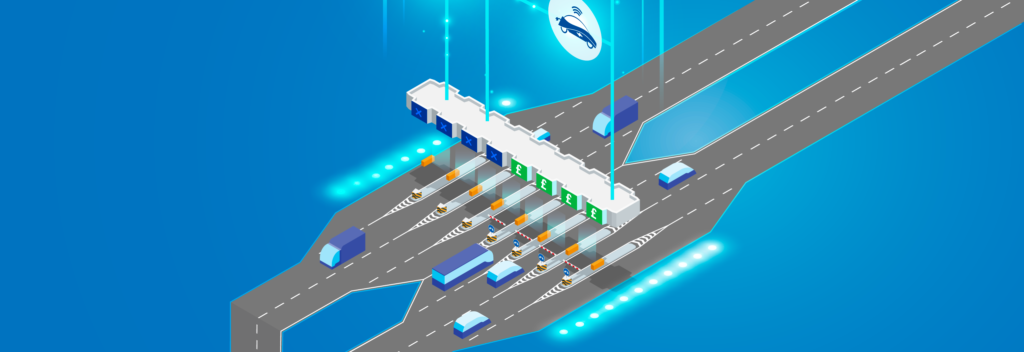Interest in road user charging is growing worldwide. Paying per kilometer, i.e. for car use instead of car ownership, can be an effective and fairer way to tackle traffic congestion and bring us closer to achieving the climate objectives. New technology will make “user/pollutor pays” approaches cheaper and easier to introduce.
Introduction
As a society, we are gradually starting to realize that “road user charging” is inevitable as a response to the many persistent societal issues. Governments also see the potential of this instrument to achieve policy objectives in a fairer and more sophisticated way. As such, “road user charging” has been explicitly included in the European Green Deal as an instrument to be applied within the European Union. In the Netherlands, increasing numbers of mobility and political parties see road user charging as an option to achieve the objectives in the Climate Agreement. In the Netherlands, CO2 emissions must be reduced by 49% in 2030 compared to 1990. In 2018, private vehicles generated around 10% of the total CO2 emissions in the Netherlands, and around 15% of nitrogen emissions. By charging polluting cars more per kilometer than low-emission cars, the government can encourage people to drive cleaner (and quieter) cars, drive less or use public transport instead.
Road user charging is also an instrument to regulate traffic congestion. During the coronavirus pandemic, traffic congestion fell by around 30%1. We do expect that increased social interaction will soon cause congestion to rise again. Furthermore, during the second wave, people in the Netherlands seemed to be using the car just as much as before the crisis, but more spread out during a workday. Through road user charging, traffic can also be spread better after the pandemic: higher costs during rush hour, lower costs in the evening and at night.
Road user charging as part of tax reform
The Netherlands is one of the five leading countries in which electric cars already make up 1.5% of the total number of vehicles. Everyone is jubilant about that success. But it poses a dilemma for the Minister of Finance. Cars generate around €6 billion in road tax and €8.5 billion in fuel tax for the Treasury. Until 2025, electric vehicles are exempt from road tax. And they never need to be filled with tax-generating fuel. The more people drive electric or hydrogen-powered cars, the larger the corresponding hole in the budget.
Loss of tax revenue is another reason why governments, not just in the Netherlands but all over the world, are looking for forms of road user charging. Road user charging can be much more than a way to generate additional tax revenue and can lead to a fundamental reform of car taxation: paying tax per driven kilometer and no longer paying a fixed amount for owning a car or motorbike. This is a fairer system because someone who drives longer distances pays more than someone who doesn’t. It also has another positive effect. By paying for use, the private car owner (or the employer in the case of company cars) experiences a much more direct connection between driving and the costs. Road tax (which is linked to the type of car) is now often collected automatically. The driver pays the tax and has no incentive to adjust their driving habits.
From local initiatives to national coverage
From experience with different tolling schemes, we know that paying for use can lead to different traffic flows. Anyone who would rather not pay the péage in France can choose an alternative route. In the Netherlands, we see the same behavior relating to some of our toll tunnels, such as the Westerschelde and Kil tunnels. For several years, low emission zones introduced in cities (for example in Amsterdam, Rotterdam, Utrecht, Antwerp and London), have led to significant reductions in traffic congestion and emissions, creating great support among residents who were often initially opposed to the system. In many European countries for many years, there has been a special toll for the transport sector. The Netherlands also wants to introduce a form of toll charge for heavy goods vehicles.
Our southern neighbors are among the first in Europe to take the next step. According to the plans, private cars – next to freight traffic – will also be required to pay per kilometer to travel into “Brussels Hoofdstedelijk Gewest”. Plans for the system include a fixed payment plus an extra charge per kilometer. Brussels wants to introduce SmartMove – KPMG is one of the parties that advises on the implementation of road user charging in the Brussels Hoofdstedelijk Gewest – in 2022, and plans to vary these charges: driving in cleaner cars and/or in off-peak hours is cheapest.
The Brussels plan shows that distance-related road user charging for light vehicles is taking increasingly concrete forms. This represents a shift in the focus of policy makers towards forms of road user charging for larger areas of the road network.
The convenience of the smartphone
The current attention for applying road user charging to larger areas of the road network is possible thanks to continued technological developments. Paying per kilometer is not new. In the 1990s, the Dutch government wanted to introduce “road pricing”. This did not go ahead, one of the reasons being that it required the installation of an expensive registration box in every car. Furthermore, it would have been necessary to install ingenious roadside equipment. Road pricing was consequently expensive and impractical and triggered personal privacy concerns.
An innovation which is currently being developed by various market parties as “proof of concept” concerns the use of smartphones as registration equipment. Most people have a smartphone nowadays, which offers the potential to make the system simpler and cheaper to implement. Using GPS, the app accurately records the route covered on the smartphone and the date and time of the trip. An amount is automatically generated and deducted from the driver’s account.
There is currently no large-scale system in the world for kilometer charging that is based on GNSS2 which integrally relies on the use of smartphones. However, various market parties are already working on developing possible solutions. We expect this development to continue, offering concrete solutions in the coming years. The Smartmove in Brussels Hoofdstedelijk Gewest, for example, will primarily be based on smartphones.
Use of system architecture as “enabler”
Technology is no longer the problem when paying per kilometer. In fact, it offers opportunities. The speed with which new technologies are being developed increases the feasibility and effectiveness of introducing road user charging in the future. As long as this is applied within the right system architecture, it can operate as an “enabler”.
Interoperability between systems is crucial in this matter. It requires smart choices by governments, so that all European national and regional initiatives (kilometer charging, toll, rush hour and congestion charge (e.g. London), cordon charge, low emission zones) can be integrated in one coherent and relatively easy system. This also requires a cohesive system of agreements about data exchange, as already introduced by the European EETS guideline. This interoperability ensures that the user can use different toll systems at home and abroad with one device. This convenience of use will help boost support.
Ideally, the central system architecture can support regional and local initiatives. As outlined earlier, forms of road user charging are being considered at various government levels. Systems should not only be interoperable; they should also offer room for local government authorities to place their own accents in order to integrate local initiatives in the central system. In general, governments should make a conscious and realistic decision about which policy objectives they wish to achieve. Wanting to achieve too many objectives at the same time, or contradictory objectives, will reduce the chance of success.
With the right system architecture, the government can also promote the development of new services. Many different useful applications can be linked to the arrival of road user charging. Again, the key factor must be convenience of use for the road user whereby, based on the road charging system (and the resulting insights), various suitable and additional (value-adding) services can be delivered, such as offering car insurance per kilometer. The integration in Mobility-as-a-Service (MaaS) concepts creates interesting perspectives, such as providing an integrated platform enabling real-time price and travel time comparisons for a certain trip based on different transport modalities. Especially since the Netherlands has – compared to many other countries – a denser and better network of public transport which can offer a good alternative to the car. This also contributes to increasing support in society.
Conclusion: a coherent system requires a smart approach
We can conclude that technology is no longer part of the problem but can be part of the solution. This requires us to make smart choices now. It is important to allow current initiatives to develop further instead of blocking them by trying to connect these initiatives upfront, making everything unnecessarily complex. At the same time, we have to make sure that the architecture in which these initiatives take place operates as an “enabler” to safeguard coherence, convenience and added value in the future.
Notes
- See also [MIW20]: Background report ‘Monitoring mobility during COVID-19’ by the Dutch Ministry of Infrastructure and Water Management, dated 30 September 2020.
- GNSS: Global Navigation Satellite System, a form of satellite navigation.
Reference
[MIW20] Ministerie van Infrastructuur en Waterstaat (2020, September 30). Achtergrondrapportage ‘Monitoring mobiliteit tijdens COVID-19’. Retrieved from: https://www.werkslimreisslim.nl/wp-content/uploads/sites/2/2020/08/20200930-Achtergrondrapportage-Monitoring-Mobiliteit.pdf





